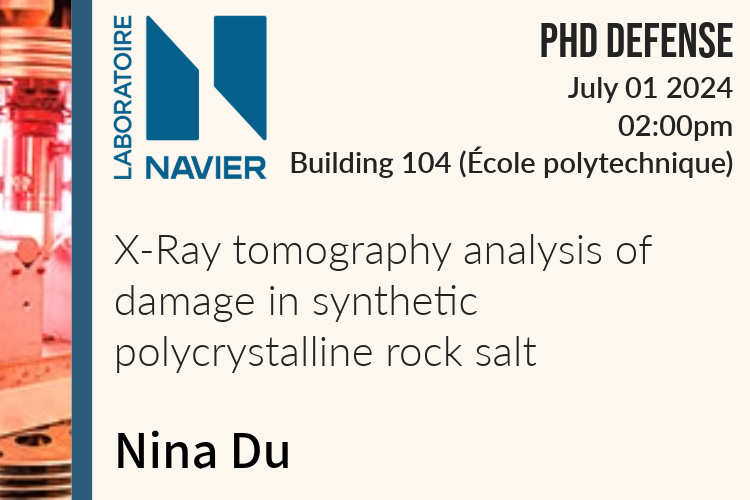
PhD Defense – Nina Du
- Post by: Mathias Lebihain
- 30 June 2025
- No Comment
Nina, a PhD candidate in the Multiscale team and in collaboration with LMS, will defend her dissertation titled “X-Ray tomography analysis of damage in synthetic polycrystalline rock salt: effect of confining pressure, brine and strain rate “ on Tuesday, July 1st, at 2:00 PM, in the Building 104 at École polytechnique.
Composition of the jury:
- Olivier CASTELNAU – Directeur de Recherche, École Nationale Supérieure d’Arts et Métiers (PIMM) – Reviewer
- Florian FUSSEIS – Professor, RWTH Aachen University – Reviewer
- Laura BLANCO-MARTÍN – Chargée de recherche, École des Mines de Paris (Centre de Géosciences) – Examiner
- Maurine MONTAGNAT RENTIER – Directrice de Recherche, Institut des Géosciences de l’Environnement – Examiner
- Christopher SPIERS – Emeritus Professor, Utrecht University – Guest
- Alexandre DIMANOV – Directeur de recherche, École Polytechnique (LMS) – Supervisor
- Michel BORNERT – Ingénieur Général des Ponts, Eaux et Forêts, École Nationale des ponts et chaussées (Navier) – Co-supervisor
You can follow the defense online on Zoom.
Abstract
Show the abstract
In a context of reduction of greenhouse gases emission, green hydrogen, produced from renewable energy sources, is considered as a promising energy vector. Its large-scale storage in deep salt caverns is a potential solution considered to deal with the time gap between the energy production and its use. Indeed, rock salt is a rock with low porosity, low permeability and is inert to hydrogen. Salt caverns have already been in use for seasonal storage of hydrocarbons. However, the intermittency of renewable energy sources means that injection/withdrawal cycles have to be more frequent. Adapting this storage solution to hydrogen therefore requires the ability to ensure the tightness and integrity of the structures under these new types of loading conditions.
Previous microscopy observations on the surface of dry synthetic polycrystalline salt samples tested under uniaxial loading conditions have highlighted the coexistence of intra-crystalline and inter-crystalline deformation mechanisms, such as grain boundary sliding. These mechanisms lead to micro-cracking of the material from the early stages of the plastic deformation. The aim of the present work is to extend these analyses to triaxial loading conditions, which are more representative of the operating conditions in salt caverns, with an observation of the evolution of porosity and micro-cracking inside the samples. In order to achieve this, 3D imaging using X-Ray tomography combined with in situ mechanical testing has been extensively used.
The study is performed on synthetic material with controlled microstructure, in which the grain size is suited to in situ mechanical testing means. Samples with different brine contents can be produced with the elaboration processes using NaCl powder pressing that have been implemented. This enables the study of the effect of humidity on the activation of damage micro-mechanisms. The microstructure of the obtained material is characterised with optical and electronic microscopy and with EBSD.
An in situ triaxial machine, that has been modified for the needs of the study, allows us to observe the development of micro-cracks at different confining pressures using laboratory and synchrotron X-Ray computed micro-tomography. The high flux of the synchrotron radiation enables shorter scan durations compared to the ones in laboratory, so that several combination of confining pressures and loading rates could have been tested on dry and wet samples. Cross-sections in the 3D volumes allow the observation of micro-crack initiation and evolution. The very high-resolution imaging modes used enable micro-cracks to be distinguished at early stages of the deformation.
Under the testing conditions considered, the viscoplastic deformation of salt is accompanied by diffuse grain boundary micro-cracking, indicating that mechanisms at the interfaces of grains are necessary mechanisms to accommodate the local plastic incompatibilities between neighbouring grains, even under significant confinements, representative of the lithostatic pressure of many salt caverns.
While micro-cracking inside the samples is observed in all the tests performed, an increase of the confinement and the presence of brine seem to reduce the development of the micro-crack network. This suggests that dissolution precipitation mechanisms could be active and serve as local accommodation mechanisms or operate as healing mechanisms.
Aiming a more systematic comparison between the different tests, suitable image filtering and analysis methods are outlined for a more precise and accurate quantification of the opening of micro-cracks in the whole volume of the samples from the very first signs of damage.


